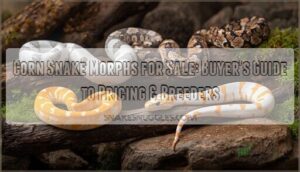This site is supported by our readers. We may earn a commission, at no cost to you, if you purchase through links.
You won’t find many reptiles that pack this much visual punch into such a low-maintenance package. Corn snakes deliver jaw-dropping color variations without the complex care requirements that scare off new keepers.
A basic morph might run you $40, while a stunning Palmetto with its hand-painted pattern can command $500 or more. The explosion of breeding projects over the past decade means you’ve got access to morphs that didn’t exist five years ago—creamy Ultramels, pure white Blizzards, and grayscale Anerythristics that look like living art.
Finding the right morph means balancing your budget against your aesthetic preferences, then tracking down breeders who ship healthy animals with solid guarantees.
Table Of Contents
- Key Takeaways
- Why Buy Corn Snake Morphs?
- Most Popular Corn Snake Morphs for Sale
- Comparing Corn Snake Morph Prices
- Choosing The Right Corn Snake Morph
- Buying Corn Snake Morphs Online
- Frequently Asked Questions (FAQs)
- How much is an albino corn snake for sale?
- What is the darkest corn snake morph?
- Is a 20 gallon good for a corn snake?
- How much does a corn snake morph cost?
- Are there any corn snake morphs?
- Where can I find cornsnake morphs?
- Which corn snake morphs are selectively bred?
- What is the rarest corn snake morph?
- How long do assorted corn snake morphs get?
- What morph is a black corn snake?
- Conclusion
Key Takeaways
- Corn snakes deliver stunning visual variety across dozens of morphs—from $40 basic patterns to $500+ rare Palmettos—without demanding complex care routines that trip up new keepers.
- Smart morph selection balances your aesthetic goals against budget realities, with albinos and ghosts offering beginner-friendly genetics while designer combos require breeding experience to avoid genetic surprises.
- Online purchasing demands vetting breeders for shipping guarantees, health documentation, and transparent genetics records—customer reviews revealing accurate arrivals matter more than flashy marketing claims.
- Proper husbandry trumps morph rarity every time, since even the most expensive designer patterns fail without consistent temps, feeding schedules, and stress-free handling protocols.
Why Buy Corn Snake Morphs?
You want a snake that breaks the mold without breaking your routine. Corn snakes deliver that perfect mix of stunning looks and straightforward care that makes ownership feel less like a chore and more like a choice.
Corn snakes break the mold with stunning looks and straightforward care that makes ownership feel like a choice, not a chore
Here’s why both first-timers and seasoned keepers keep coming back to these colorful colubrids.
Appeal for Beginners and Enthusiasts
Corn snake morphs offer something for everyone. Beginners appreciate manageable care and visual variety—from albinos to ghosts. Enthusiasts chase rare designer morphs for genetic exploration and collection expansion. You’ll find:
- Beginner-friendly options that simplify pet snake ownership
- Diverse morphs fueling enthusiast collections
- Strong breeder networks supporting breeding ethics
Positive experiences prove corn snake breeding delivers vigorous health when you follow proper husbandry. The scientific community relies on methodological rigor to guarantee accurate research findings.
Unique Morphs and Color Variations
You’ll discover morphs that rewrite the rules of snake pigmentation. Blizzard variants flash zebra-like bands on white, while Palmetto corn snake morphs blend black and gold tones you won’t find anywhere else.
Ultramel corn snake breeding unlocks caramel-rich hues through sophisticated color genetics.
Pattern expression shifts with Ghost and Snow morphs—melanin reduction creates translucent tones that challenge standard morph classification.
Designer rare variants combine multiple genes for unpredictable results.
Ease of Care and Handling
Beyond genetics and visual appeal, you’ll appreciate how pet corn snake care fits seamlessly into your schedule. Handling techniques remain straightforward when you follow basic guidelines. Proper snake temperament develops through consistent care routines paired with stable environmental factors.
For stress management in reptile care:
- Support the body fully during 5-15 minute sessions
- Skip handling 24-48 hours after feeding
- Wash hands before and after contact
Pet snake care builds confidence fast when you respect their rhythm.
Customer Satisfaction and Reviews
Real buyers tell the story better than any sales pitch. Review analysis reveals three trust signals that boost buyer confidence: verified purchases with detailed snake morph descriptions, fast breeder responses, and transparent genetics documentation. Customer feedback on reptile breeding operations shows satisfaction metrics spike when pet snake arrivals match online listings exactly. Your research starts with reading what other keepers experienced.
| Trust Signal | What Buyers Report | Impact on Confidence |
|---|---|---|
| Verified Purchase Tags | Accurate morph colors and sizes | High reliability indicator |
| Breeder Communication | Quick responses on feeding and care | Builds repeat buyer relationships |
| Genetics Documentation | Correct lineage for snake breeding | Reduces post-purchase regret |
| Shipping Transparency | Temperature-controlled packaging details | Ensures safe corn snake arrival |
Most Popular Corn Snake Morphs for Sale
You’re stepping into a world where color isn’t just decoration—it’s your personal statement. Some morphs flash bold reds and whites that demand attention, while others whisper in silvers and grays with quiet confidence.
Here’s a breakdown of the most sought-after corn snake morphs that let you choose exactly who you want to be as a keeper.
Albino Corn Snakes
If you’re chasing pure visual impact, albino corn snakes deliver with bright yellows and fiery orange-red accents where darker pigments vanish. Albino genetics run recessive, so you’ll need two copies for that knockout color pattern. Here’s what makes them stand out:
- Striking coloration – vivid base tones replace melanin-driven blacks and browns
- Beginner-friendly – same reptile care demands as standard corn snake morphs
- Breeding versatility – pair with compatible morphs for designer offspring
Morph breeding creates opportunities for endless combinations.
Anerythristic Corn Snakes
Anerythristic corn snakes strip out red pigment completely, leaving sharp grayscale patterns that pop against clean white or silver bodies. This recessive genetic trait demands two carriers to produce offspring with those high-contrast bands.
You’ll find them priced similarly to albinos, and they pair beautifully in breeding projects when you’re hunting designer color patterns that break from traditional orange-red aesthetics.
Blizzard Corn Snakes
Blizzard corn snakes deliver a nearly white body with minimal pattern contrast, thanks to recessive blizzard genetics that both parents must carry. Those bright red or orange eyes make them stand out in any collection.
You’ll pay premium prices when breeders pair blizzard with other desirable snake morphs, creating stunning designer combinations.
Standard corn snake care and reptile handling apply—no specialized feeding or temperature tweaks required.
Palmetto Corn Snakes
Palmetto corn snakes bring a truly wild card to the table—white or pale ground with scattered dark markings that look hand-painted. You’re getting an incompletely dominant gene mutation that produces unpredictable patterns every time.
Here are the key characteristics of Palmetto corn snakes:
- Genetic Traits: Both parents pass unique pigmented alleles for paler ground color
- Color Patterns: Expect bold dorsal stripes with reduced black pigmentation
- Morph Stability: Multiple generations stabilize the Palmetto trait in breeding lines
- Snake Behavior: Regular handling keeps these pet snake morphs docile and calm
- Breeding Methods: Paired programs aim for predictable Palmetto offspring across successive generations
Quarantine new arrivals and watch for common snake husbandry issues.
Ultramel Corn Snakes
Ultramel corn snakes deliver creamy peach tones with reduced black contrast—a recessive trait that requires two alleles to show its full warmth. You’re looking at softer patterns and coral undertones that brighten when crossed with albino lines.
Proper snake nutrition and temperatures between 65–85°F keep these pet snake morphs thriving through every shed cycle.
| Genetic Traits | Color Patterns | Morph Variations |
|---|---|---|
| Recessive inheritance | Creamy to peachy hues | Homozygous vs. heterozygous |
| Two-copy expression | Reduced melanin | Linked co-dominant traits |
| Pedigree documentation | Warm coral undertones | Albino cross outcomes |
| Genotype verification | Diminished dorsal contrast | Temperature-influenced pigment |
Ghost and Snow Corn Snakes
Ghost corn snakes strip away heavy black pigmentation, giving you lighter bodies and smoother contrast—perfect if you want understated elegance in your collection.
Snow corn snakes flip the script with near-white scales and red eyes, a knockout combo of recessive genetic variations.
Breeding techniques that pair these morphs create Ghost Snow hybrids, blending pale backgrounds with bold pattern definition—color patterns that demand a second look.
Rare and Designer Morphs
Beyond the classics, rare and designer morphs—flame patterns, candy-based combos—live in limited breeding stock where dedicated breeders control color patterns and corn snake genetics.
Market trends swing with reptile expo buzz and online demand. You’ll pay premium prices, but reputable sellers back claims with pedigrees, health guarantees, and post-purchase guidance that reflects breeder ethics and solid snake husbandry.
Comparing Corn Snake Morph Prices
You’re probably wondering what you’ll actually pay for different corn snake morphs. Prices swing wildly depending on genetics, visual appeal, and how rare a particular color pattern is.
Let’s break down what drives these price tags and what you can expect to spend.
Price Ranges by Morph
You’ll find corn snake price tags shift dramatically across morphs. Albino babies start at $150 to $400, while anerythristics run $120 to $350. Blizzard morphs command $350 to $800 for hatchlings, reflecting those striking color variations. Palmetto snakes range from $200 to $600, and ultramels sit between $250 and $700.
Breeder reputation and market trends influence these brackets as much as genetic factors do.
Influence of Genetics and Rarity
Genetic variation drives everything you see in corn snake morphs. Albino and anerythristic alleles shape coloration through codominant or recessive trait inheritance, creating phenotype diversity that collectors chase.
Rare morphs with limited breeding constraints push prices higher because:
- Recessive genes require strategic pairing
- Color genetics produce unpredictable outcomes
- Snake genetics determine health stability
- Lineage verification affects buyer confidence
- Regional availability restricts access
Color morphs become investment pieces when genetic rarity meets visual impact.
Age, Size, and Visual Traits
You’re buying a living canvas that changes as it grows. Hatchling corn snakes measure 7 to 14 inches, but growth patterns push most pet corn snake morphs to 4 to 6 feet within two years. Color intensity sharpens after the first shed cycle, and scale texture becomes more pronounced with age.
Younger snake morphs and genetics show less saturated hues, while adult snake color morphs reveal their full visual potential through proper morph development.
Market Trends and Seasonal Availability
Spring and early summer usually bring the most active market cycles for corn snake morphs and genetics. You’ll notice price fluctuations tied to seasonal demand as reptile breeding programs release new litters. Geographic trends show warmer regions stock earlier, while breeder networks offer priority access during peak months. Corn snake price stability returns by fall when:
- Inventory levels normalize after summer rush
- Shipping conditions improve with moderate weather
- Bundle discounts emerge to stimulate off-season sales
- Snake morphs and genetics settle into predictable ranges
Choosing The Right Corn Snake Morph
Picking your first corn snake morph isn’t about following trends or buying the flashiest pattern. You want a snake that matches your comfort level, fits your vision, and thrives under your care.
Here’s how to narrow down your options and find the morph that’s actually right for you.
Beginner-Friendly Morph Options
Your first pet snake should make learning easy, not complicated. Normal and albino corn snakes top the beginner snake list because their genetics stay simple, their patterns stay visible for health checks, and their temperament stays predictable. These color morphs avoid the hidden recessive traits that surprise novice breeders later.
Choose morphs with strong contrast so you’ll spot retained shed or swelling fast. Widely available beginner resources confirm captive-bred basics tolerate typical room temps without stress. Skip the designer combos until you understand breeding basics and snake handling confidence grows.
| Morph | Why Beginners Love It | Average Price |
|---|---|---|
| Normal/Classic | Clear patterns, sturdy health | $40–$60 |
| Amelanistic Albino | Food-motivated, docile nature | $70–$90 |
| Anerythristic | Straightforward single-gene trait | $65–$85 |
| Ghost | Easy visual health monitoring | $70–$95 |
Temperament and Handling Needs
You deserve a pet snake that won’t freak out every time you reach into the enclosure. Most corn snakes stay calm with gentle socialization techniques, tolerating regular handling sessions of ten minutes three times weekly.
Stress management starts simple: skip handling during sheds, wait two days post-feeding, and watch for tail rattles or hissing.
Temperament tests reveal individual snake behavior fast, giving you control over your reptile pet care journey from day one.
Color and Pattern Preferences
Your eye catches what it wants, and pigment variation drives that instinct hard. Albino corn snake morphs and high-contrast patterns signal vitality you can see across the room. Pattern genetics determine whether you get bold dorsal bands or irregular blotching that screams one-of-a-kind.
- Brighter color morphs with red or pink elements create instant visual appeal
- Melanin-reduced morphs show clearer base colors that pop under any lighting
- Rarity factors like unique blotching command premium prices for serious collectors
- Morphology changes as juveniles mature, revealing hidden pattern genetics over time
Health and Feeding Considerations
You’ll dodge most headaches by nailing habitat maintenance from day one—spot-clean substrate and check temps weekly.
Feeding techniques matter: juveniles eat every 5–7 days, adults stretch to 7–10. Match prey size to your snake’s girth, around 1–2% of body weight.
Stress management through calm handling keeps dietary needs consistent. Frozen-thawed prey beats live for reptile care and maintenance safety.
Buying Corn Snake Morphs Online
Ordering your corn snake online puts you in control from the first click to delivery day. You’ll want a breeder who ships with care, answers your questions fast, and stands behind every snake they send.
Here’s what separates the pros from the pretenders when you’re buying online.
Reputable Breeder Selection
Finding the right breeder puts you in control of your snake’s future health and temperament. Reputable reptile breeding operations separate you from guesswork and connect you with captive-bred animals raised by genuine reptile enthusiasts who understand snake pedigree and breeding ethics.
When selecting a breeder, consider their expertise in providing proper corn snake care. Look for breeders who offer:
- Customer reviews that detail healthy arrivals and accurate morph descriptions
- Clear information on your corn snake’s genetic background and feeding history
- Transparent communication about breeding practices and animal care standards
Shipping, Packaging, and Guarantees
Once you’ve picked your breeder, shipping becomes your next checkpoint. Reputable operations use insulated Packaging Materials and Temperature Control methods—heat packs in winter, cold packs in summer—to protect your snake during FedEx Priority Overnight transit.
Expect Shipping Costs around $39 and a Live Arrival Guarantee backed by photographic proof requirements.
Handling Instructions arrive with your Captive Breeding specimen, ensuring you control every step from Overnight Delivery to first feeding.
Customer Support and Aftercare
Your snake arrives—now the real adventure starts. Strong breeders offer Health Guarantees spanning two to four weeks, backed by email or phone Support Channels for Post Purchase Care questions.
You’ll get written Pet Snake Care sheets covering feeding schedules, temperature tweaks, and quarantine protocols—Aftercare Services that prove Animal Shipping and Handling doesn’t end at your doorstep.
Customer Feedback loops keep Pet Ownership and Responsibility sharp.
What to Expect When Ordering
Before you click buy, walk through the Order Process—review Shipping Terms, confirm Payment Options, and scan Return Policies for your Captivebred Pet Snake.
Health Guarantees protect live arrival of your Corn Snake, while Animal Shipping and Handling protocols guarantee safe transit.
Reputable Corn Snakes for Sale listings spell out every detail, so you’re ordering with eyes wide open.
Frequently Asked Questions (FAQs)
How much is an albino corn snake for sale?
Like finding a rare gem at a fair price, albino corn snakes usually run $50 to $200. Juvenile morphs start cheaper, while adults with documented snake genetics and breeder reputation command premium pet costs.
What is the darkest corn snake morph?
The darkest morphs feature charcoal-to-black ground color with minimal contrast.
Melanistic traits suppress lighter pigments, creating shadow snakes with deep patterns.
Multi-gene combos—not single alleles produce the most dramatic black genetics.
Is a 20 gallon good for a corn snake?
Looking for the right enclosure size? A 20-gallon tank works for juveniles, but adult corn snakes thrive in 40-gallon setups with proper temperature control, substrate depth, and climbing branches for ideal pet snake health.
How much does a corn snake morph cost?
Corn snake cost ranges from $40 to $400, depending on morph pricing and snake genetics. Color variations like Albino and Ghost start around $60, while designer morphs with rare color morphs command breeder fees exceeding $
Are there any corn snake morphs?
Yes, dozens of corn snake morphs exist through selective breeding techniques. Species variations include Albino, Anerythristic, Blizzard, Palmetto, Ultramel, Ghost, and Snow.
Morph genetics determine snake coloration patterns, making each pet corn snake unique.
Where can I find cornsnake morphs?
You’ll find corn snake morphs through specialized reptile marketplaces like MorphMarket, online breeders such as South Mountain Reptiles, regional expos, and snake forums where keepers share trusted breeder networks and seller recommendations.
Which corn snake morphs are selectively bred?
All captive breeding programs produce selectively bred corn snakes through deliberate morph selection. Albino, Anerythristic, Blizzard, Palmetto, and Ultramel morphs showcase targeted breeding techniques that manipulate color genetics and pattern development for specific genetic variations.
What is the rarest corn snake morph?
The Blizzard and Palmetto morphs stand among the rarest color morphs in the hobby. Limited breeders produce these genetic variations annually, making them prized for their unique color patterns and snake morphology complexity.
How long do assorted corn snake morphs get?
Most color morphs reach adulthood between four and six feet, though genetics and early nutrition act as invisible architects shaping final length.
Ultramels and Blizzards usually grow slightly shorter than their Albino cousins.
What morph is a black corn snake?
True black corn snakes don’t exist as a single morph. What you’re seeing is usually dark patterns from melanin-heavy combinations like anerythristic or lava variants. Genetic testing reveals the real lineage behind these striking appearances.
Conclusion
Think of your collection as a living canvas that evolves with every feeding cycle and shed. The corn snake morphs for sale today represent decades of selective breeding distilled into animals that thrive under your care.
You’ve mapped the price brackets, vetted the breeders, and identified the patterns that make your pulse quicken. Now you skip the hesitation and claim the morph that turns your vision into reality—because waiting only limits your options.
- https://academichelpexpress.blog/2024/08/please-use-the-bulleted-points-and-the-rubric-below-to-guide-your-work-your-pa/
- https://x.com/godofprompt/status/1990526288063324577
- https://www.sciencedirect.com/science/article/pii/S0749208123000268
- https://arxiv.org/html/2507.17948v2
- https://www.scribd.com/document/683678057/Academic-Research-Manual-V1-1-April-2016

















